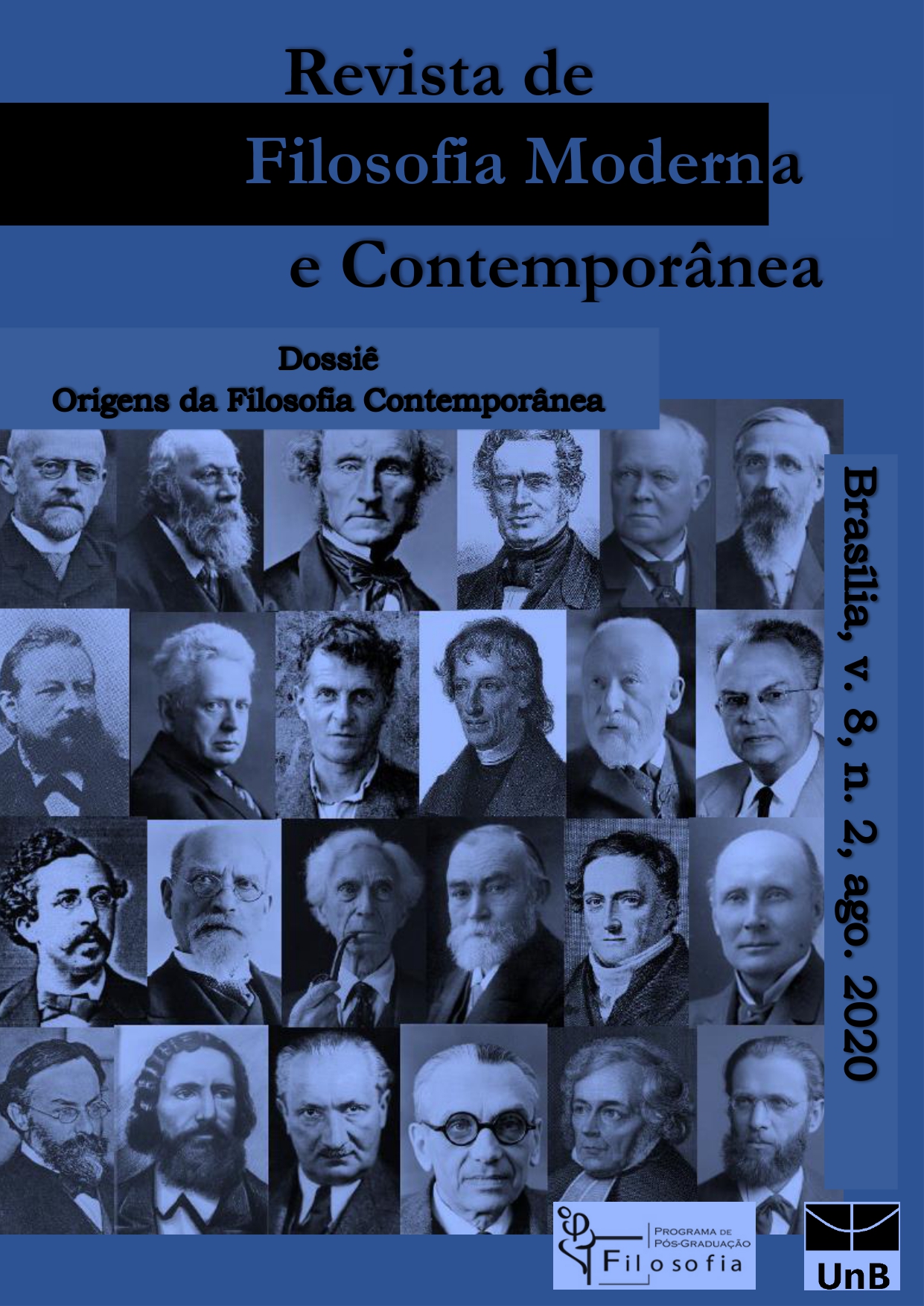Harald Høffding and the Historical Roots of the Bohrian Concept of Symbol
DOI:
https://doi.org/10.26512/rfmc.v8i2.35863Keywords:
Analogy. Niels Bohr. Harald Høffding. Symbol.Abstract
In this paper we analyze the historical roots of the Bohrian concept of symbol. More precisely, we argue that Bohr takes Kantian elements from Høffding´s philosophy in order to develop his own concept of symbol. For this purpose, firstly, we focus on the two different senses that Bohr gives to the concept of symbol. Then, we study how each of these senses is related to different aspects of Høffding’s philosophy and we show the connection between the Bohrian and the Kantian concept of symbol by means of Høffding’s mediation.
Downloads
References
BOHR, N. Chemistry and The Quantum Theory of Atomic Constitution in Causality and Complementarity. The Philosophical Writings of Niels Bohr, vol. IV, Faye, J. and Folse, H. (eds.). Ox Bow, Woodbridge, Connecticut, 1998
______. Atomic Theory and the Description of Nature. Cambridge University Press: Cambridge, 1934.
______. Atomic Physics and Human Knowledge, John Wiley & Sons: New York, 1958.
______ Causality and Complementarity. The Philosophical Writings of Niels Bohr, vol. IV, Faye, J. and Folse, H. (eds.), Ox Bow, Woodbridge, Connecticut, 1998.
CASSIRER, E. Determinism and Indeterminism in Modern Physics, Benfey, T. (trans.), Yale University Press: New Haven and London, 1956.
CHRISTIANSEN, F. Heinrich Hertz’s Neo-Kantian Philosophy of Science and its Development by Harald Høffding. Journal for General Philosophy of Science, 37, pp. 1 -20, 2006.
D’AGOSTINO, S. The Bild Conception of Physical Theory: Helmholtz, Hertz, and Schrodinger. Physics in Perspective 6, pp. 372”“389, 2004
DARRIGOL, O. From C-numbers to Q-numbers. The Classical Analogy in the History of Quantum Theory. University of California Press: Berkeley, 1992.
FAVRHOLDT, D. Niels’s Bohr Philosophical Background. Historisk-filosofiske Meddeleser, 63. The Royal Danish Academy of Sciences and Letters, Copenhagen, 1992.
FAYE, J. Niels Bohr: His Heritage and Legacy. An Anti-Realist View of Quantum Mechanics. Kluwer, Dordrecht, 1991.
FERRARI M. Sources for the History of the Concept of Symbol from Leibniz to Cassirer in Symbol and Physical Knowledge. Springer: Berlin, 2002.
FERRARI, M., STAMATESCU, I.-O. (eds.) Symbol and Physical Knowledge. Springer: Berlin, 2002.
GÓMEZ, R. Resonancias kantianas en el pensamiento de Bohr. Revista Latinoamericana de Filosofía, XIII, pp. 3 ”“ 23, 1987.
HELMHOLTZ, H. Epistemological Writings. The Paul Hertz & Moritz Schlick Centenary Edition of 1921, with Notes and Commentary by the Editors, Cohen, B. (ed.), Low, M. (trans.). Reidel, Dordrecht, 1977.
HERTZ, H. The Principles of Mechanics. Dover: New York, 1956
HEISENBERG, W. The physical principles of the quantum theory. Mineola: Dover, 1949
HØFFDING , H. Die Kontinuität in philosophischen Entwicklungsgange Kants. Archiv für Geschichte der Philosophie, VII, pp. 173 ”“ 192, 1984.
______. A History of Modern Philosophy. A Sketch of the History of Philosophy from the Close of the Renaissance to Our Own Days, 2 vols., Macmillan, London, 1900.
______. On Analogy and its Philosophical Importance. Mind, 14, pp. 199 ”“ 209, 1905.
______. Moderne Philosophen. Vorlesungen gehalten an der Universität in Kopenhagen im Herbst 1902, Reisland, Leipzig, 1905b.
______. Der Menschliche Gedanke, Reisland, Leipzig, 1911.
______. Der Begriff der Analogie. Reisland, Leipzig, 1923.
______. La relativité philosophique. Alcan, Paris, 1924.
HONNER, J. The Description of Nature. Niels Bohr and the Philosophy of Quantum Physics. Clarendon Press, Oxford, 1987.
KANT, I. Kants gesammelte Schriften (AA). Königlichen Preußischen (Deutschen) Akademie der Wissenschaften: Berlin. 1902 ff.
______. Critique of Pure Reason Cambridge University Press: Cambridge, 1998.
______. Theoretical Philosophy after 1781. Cambridge University Press: Cambridge, 2002.
MACH, E. Erkenntnis und Irrtum, Barth, Leipzig, 1926.
MAXWELL, J. C. The Scientific Papers. Niven, W. (ed.) (1965), Dover, New York, 1890.
PRINGE, H. Critique of the Quantum Power of Judgment. A Transcendental Foundation of Quantum Objectivity. de Gruyter, Berlín, 2007.
______. Cassirer and Bohr on intuitive and symbolic knowledge in quantum physics. Theoria, 81, p. 417-429, 2014.
ROSENFELD, L., RUD NIELSEN, J., RÜDINGER, E., AASERUD, F. (eds.) Bohr’s Collected Works (BCW). North-Holland, Amsterdam; American Elsevier, New York, 1972.
STOLZENBURG, K. Die Entwicklung des Bohrschen Komplementaritätsgedankes in den Jahren 1924 bis 1929, Ph.D. Thesis, Universität Stuttgart (Technische Hochschule), Stuttgart, 1977.
Downloads
Published
How to Cite
Issue
Section
License
Copyright (c) 2020 Journal of Modern and Contemporary Philosophy

This work is licensed under a Creative Commons Attribution-NonCommercial-NoDerivatives 4.0 International License.
Copyright for articles published in this journal is retained by the authors, with first publication rights granted to the journal. By virtue of their appearance in this open access journal, articles are free to use, with proper attribution, in educational and other non-commercial settings.


